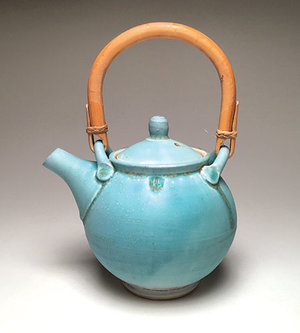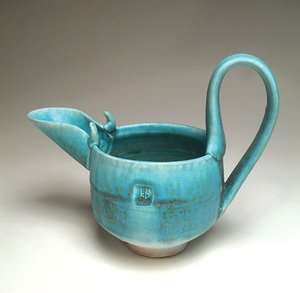“I think it was because of all these new, young teachers who had just gotten their MFAs and were coming to teach where I was going to school. They were all, you know, totally into their own work and teaching. They were young and vibrant, and I thought ‘Wow, I want to be one of them.’ The fire in them impressed me.”
Karl Borgeson spent the entirety of his artistic career teaching. In a house he built with his students, mirroring the endeavor his father undertook before him, Karl shares that as long as he had wanted to practice art, he had wanted to teach. Hearing his stories, it makes sense. Karl’s life has been shaped and crafted by his teachers and students.
Karl began as an undergraduate business major at the University of Minnesota. “All my life I had been involved in artistic pursuits in terms of drawing and painting and making things, but it didn’t occur to me that I could study art as a career. My first year [as a business major] was just horrible. I hated it.” Karl’s advisor noticed his dejectedness and invited him to complete career placement tests. She evaluated his results and, seeing “aesthetics,” pushed him towards his artistic tendencies. “I went back to school as an art major, and during my very first semester at this school, St. Cloud State University, there were five brand-new teachers. One was a pottery teacher, and a ceramics course was required for all art majors, so I signed up for that. And that was it. That was the turning point. I took that class and I decided right then and there that I wanted to work in clay and teach, so that’s what I did.”

While earning his Bachelor’s in Fine Arts, Karl got married and had a child. Afterward, he worked for a moment as an assistant professor at Humboldt State University in California. Two years after earning his BFA, Karl returned to the University of Minnesota to earn his Masters in Fine Arts in ceramics and sculpture. “I was there for two years and went on from there.”
To talk about Karl’s postgraduate move is to talk about him as a professional and artist in his prime; he landed where he would spend the duration of his career. After finishing at the University of Minnesota in 1970, Karl began teaching ceramics at the University of Wisconsin–Whitewater. He retired from the university 32 years later and is now a professor emeritus. His time spent teaching was undeniably fundamental to his creative process. “You learn probably as much from your students as you teach them,” Karl laughs. “It’s kind of amazing. There’s a lot of subtle things you can gain, especially from college-level students. I was 30 when I started at Whitewater, but my students were basically between 18 and 22. I felt really in sync with them. And I was fortunate, I think, to have had a lot of really good students—really dedicated people that would be in the studio working any time they could.”
In learning about Karl’s dynamic with his pupils, it’s clear the relationship was always mutually beneficial. As his students brought their creative energy to the wheelhouse, he invested in them more and more. Their art enabled his own to develop. For instance, Karl had focused his body of work on a firing process called raku for approximately 20 years when he found himself creatively bereft. “I felt I was sort of run out of fresh ideas. I was just repeating myself. I took some of my students down to a wood-fire conference at the University of Iowa in Iowa City. I really got turned on to the idea of wood firing.”

Prior to his time in Iowa, Karl was cultivating a body of work that was “purely more art related, more art influenced.” The bowls, teapots, and platters he was fashioning were not usable. At this conference, Karl decided to build a wood-fire kiln upon his return home and switch his priority from form to function. The shift back toward objectively functional work harkened back to his time in undergraduate and graduate school focusing on usable pottery. The difference in that moment and onward, however, would be the manual energy Karl would invest. “Of course it required a lot of physical labor. Gathering the firewood, for one, and then the firings themselves were super labor intensive. I was firing the kiln by myself.”
Venturing into his retirement, managing the arduous endeavor on his own eventually became too much. Halfway through his retirement, Karl deconstructed his kiln and rebuilt it as a gas fire kiln. Abandoning his prior technical mechanism while still keeping his new stylistic priority, Karl ventured into the second half of his retirement with an adamance toward the functional and an open mind to new style.
Not looking for it, Karl found a new appreciation for aesthetic when he and his wife visited Mali, West Africa. “The influences are a combination of architecture, of basketry, textiles, even the clothing people wore—all of this. We were there for a month. The whole time we were there we were driving from village to village, and I’m thinking about all the work I want to make when I get home.”
Though his work is untitled, it’s easy to identify which of his pieces bear the Mali influence. One of his objects features bent metal studs and a smooth rabbit-shaped metal-coated top, mirroring both the art and architecture Karl witnessed in Mali. While the studs reflect those placed in the local mud huts to allow people to ascend them and replaster their outside surfaces, the horns parallel “an amazing sculpture I saw in a museum in Mali. It was a carved wood sculpture, not a mask, but a kind of head form. It had these horns poking out, and I was just totally enthralled with it. That’s what you see in there. That’s my interpretation of these horn shapes on the sculpture I saw.”
After his initial trip to the country, Karl returned to Mali and visited Burkina Faso and Benin as well. During subsequent travel to Indonesia, Ethiopia, and Mongolia in the years of his retirement, Karl patiently and graciously found new patterns, textures, and colors to embed within his oeuvre.
-Elissa Koppel, Madison Essentials Magazine
Link to Original Article on MadisonEssentials.com
Source: https://madisonessentials.com/Article/2019-01/Karl-Borgeson
